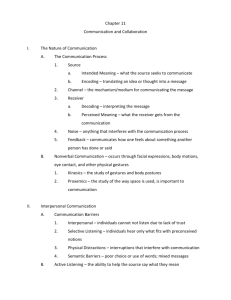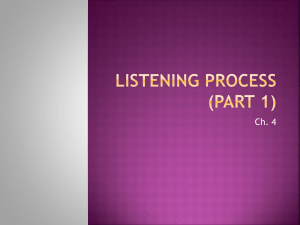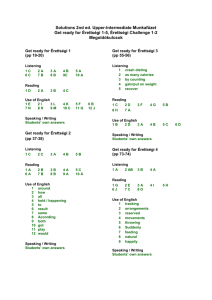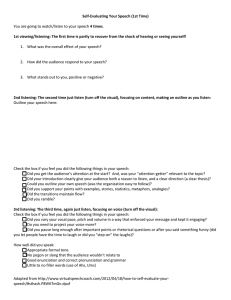Chapter 11 Effective Communication (and Total Quality)
advertisement
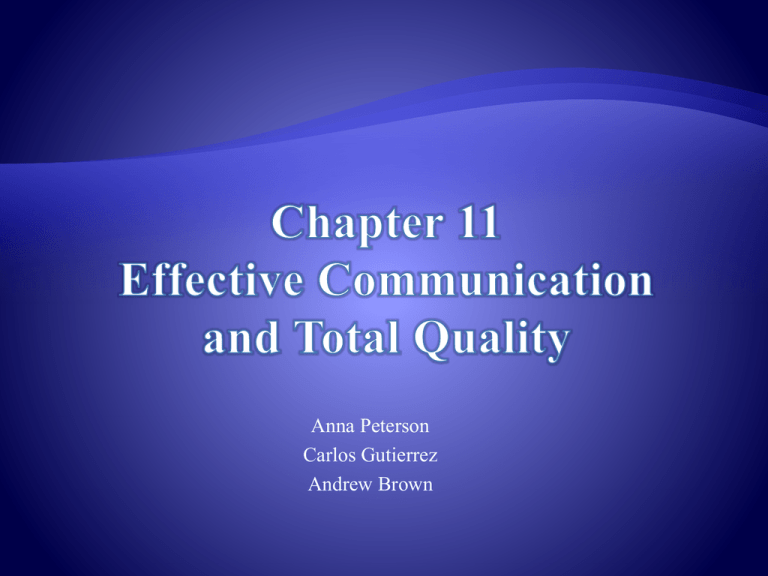
Anna Peterson Carlos Gutierrez Andrew Brown “The transfer of a message that is both received and understood” Transfer of message Idea Emotion Information Intent Feeling Four categories Dyadic Small Group Mass Communication Public Speaking No communication has occurred until message understood Message is understood by all parties When message is acted upon in desired manner Receiving Understanding Acting Persuasion Motivation Monitoring Leadership One-on-one Team (peer group) Company-level Community-level We need to look at aspects of the Total Quality Concept Customer Focus (listening and acting on their needs) Listening Asking Observing Probing Employee empowerment Leadership Inspire to make commitment Teamwork Everyone knows goals How to accomplish them Who is responsible How everything fits together http://www.youtube.com/watch?v=TzUxeCGGHnA&feature=PlayList&p=E00E 6168C97AAE99&playnext_from=PL&playnext=1&index=68 Decision Making Problem prevention Problem solving Conflict resolution Optimism Consider all points of view Be positive, honest, and consistent Message (What?) Sender (From Who?) Receiver (To Who?) Medium (How?) Verbal Non-verbal (gestures and body language) Written Electronic Differences in meaning Lack of trust Information overload Interference Condescending tone Poor listening skills Premature judgments (of topic or people) Inaccurate assumptions Blame the messenger! DON’T do the following: Be secretive and withdrawn Vague Ignore a good idea Be like Michael Scott! Listening is very important, and many people have difficulty with it “receiving the message, correctly decoding it, and accurately perceiving what it means.” Why we don’t listen: lack of concentration, interruptions, preconceived ideas, thinking ahead, interference, tuning out Empathetic Listening- intent to understand the message and messenger Don’t overtly/covertly ignore message Pretenders Responsive Listening- wanting to receive and affirm the message (Active, Alert, Vigilant, Sensitive, Creative) Body Factors- how we use our body and how someone views it Posture Dress (Hygiene) Gestures Facial Expressions Poses Not just what we say, but how we say it Volume Pitch Tone Rate of speech Where are you when communicating? Physical arrangements (inviting vs. intimidating) Environment/fixtures in the room Positions of people Show interest (eye contact, but don’t be weird about it) Be friendly (positive attitude) Be flexible Be tactful (Sensitivity to some issues, think before speaking) Be courteous 1. Drop your defenses (open up to employees and try to be objective) 2. State your purpose (why are you asking this question?) 3. Acknowledge emotions (don’t ignore what is happening) 4. Use open-ended questions and phrase they carefully (avoid yes/no questions so you can gather more information Plan before you write (I am writing to, purpose, points, want what done) Be Brief (so your readers will not zone out on your communication) Be Direct (go right to the point) Be Accurate (not ambiguous) Practice Self-Editing (review and revise) Define the problem (why are you doing this?) Develop and work plan (tasks to be completed with dates to finish) Gather relevant data (research) Process findings (understand what the data says) Develop conclusions Make reccomendations Advantages for written communication Rapid transmittal Mass communicating Acknowledgment of receipt Disadvantages no body language or voice Overuse Recognizing the need Careful selection Training Measurement and reward Value People- people over technology Give what you want back Make cooperation a habit Introversion vs. extroversion Neuroticism vs. emotional stability Agreeable vs. stubborn Conscientious vs. undependable Open to exercises vs. preference of familiar

